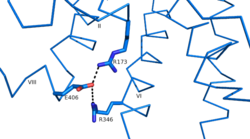Sandbox Reserved 1167
From Proteopedia
(Difference between revisions)
| Line 16: | Line 16: | ||
=== Class B vs. Class A === | === Class B vs. Class A === | ||
| - | Like all classes of glucagon receptors, which include class A ([https://en.wikipedia.org/wiki/Rhodopsin-like_receptors rhodopsin-like]), B (secretin-like), and [https://en.wikipedia.org/wiki/Class_C_GPCR C] ([https://en.wikipedia.org/wiki/Metabotropic_glutamate_receptor metabotropic glutamate]), GCGR has a 7tm domain. While class B receptors do share characteristics with class C receptors, they are more similar to class A receptors. Class B receptors and class A receptors share less than 15% sequence [https://en.wikipedia.org/wiki/Homology_(biology) homology]; however, they do share similar [https://en.wikipedia.org/wiki/Signal_transduction signal transduction] mechanisms as well as the 7tm domain. The orientations and positions of the 7tm helices are also conserved between both classes of glucagon receptors. | + | Like all classes of glucagon receptors, which include class A ([https://en.wikipedia.org/wiki/Rhodopsin-like_receptors rhodopsin-like]), B (secretin-like), and [https://en.wikipedia.org/wiki/Class_C_GPCR C] ([https://en.wikipedia.org/wiki/Metabotropic_glutamate_receptor metabotropic glutamate]), GCGR has a 7tm domain. While class B receptors do share characteristics with class C receptors, they are more similar to class A receptors. Class B receptors and class A receptors share less than 15% sequence [https://en.wikipedia.org/wiki/Homology_(biology) homology]; however, they do share similar [https://en.wikipedia.org/wiki/Signal_transduction signal transduction] mechanisms as well as the 7tm domain. The orientations and positions of the 7tm helices are also conserved between both classes of glucagon receptors<ref name ='structure_article'>PMID:23863937</ref>. |
| - | However, one particular difference between class A receptors and class B receptors is an inward shift of the intracellular component of Helix VII. In class A receptors this inward shift is instrumental in receptor activation, yet in class B receptors it remains unclear what role this shift plays. | + | However, one particular difference between class A receptors and class B receptors is an inward shift of the intracellular component of Helix VII. In class A receptors this inward shift is instrumental in receptor activation, yet in class B receptors it remains unclear what role this shift plays<ref name ='structure_article'>PMID:23863937</ref>. |
In contrast to class A glucagon receptors which have a [https://en.wikipedia.org/wiki/Proline proline] kink, in all [https://en.wikipedia.org/wiki/Secretin_receptor_family secretin-like class B glucagon receptors] a [https://en.wikipedia.org/wiki/Glycine Glycine] at position 393 in Helix VII allows for a <scene name='72/721537/Gly_393_helical_bend/1'>helical bend</scene>. This glycine helical bend is fully [https://en.wikipedia.org/wiki/Conserved_sequence conserved] in all secretin-like class B receptors. | In contrast to class A glucagon receptors which have a [https://en.wikipedia.org/wiki/Proline proline] kink, in all [https://en.wikipedia.org/wiki/Secretin_receptor_family secretin-like class B glucagon receptors] a [https://en.wikipedia.org/wiki/Glycine Glycine] at position 393 in Helix VII allows for a <scene name='72/721537/Gly_393_helical_bend/1'>helical bend</scene>. This glycine helical bend is fully [https://en.wikipedia.org/wiki/Conserved_sequence conserved] in all secretin-like class B receptors. | ||
Revision as of 06:07, 19 April 2016
| This Sandbox is Reserved from Jan 11 through August 12, 2016 for use in the course CH462 Central Metabolism taught by R. Jeremy Johnson at the Butler University, Indianapolis, USA. This reservation includes Sandbox Reserved 1160 through Sandbox Reserved 1184. |
To get started:
More help: Help:Editing |
Class B Human Glucagon G-Protein Coupled Receptor
References
- ↑ Lotfy M, Kalasz H, Szalai G, Singh J, Adeghate E. Recent Progress in the Use of Glucagon and Glucagon Receptor Antago-nists in the Treatment of Diabetes Mellitus. Open Med Chem J. 2014 Dec 31;8:28-35. doi: 10.2174/1874104501408010028., eCollection 2014. PMID:25674162 doi:http://dx.doi.org/10.2174/1874104501408010028
- ↑ 2.0 2.1 2.2 2.3 2.4 2.5 Siu FY, He M, de Graaf C, Han GW, Yang D, Zhang Z, Zhou C, Xu Q, Wacker D, Joseph JS, Liu W, Lau J, Cherezov V, Katritch V, Wang MW, Stevens RC. Structure of the human glucagon class B G-protein-coupled receptor. Nature. 2013 Jul 25;499(7459):444-9. doi: 10.1038/nature12393. Epub 2013 Jul 17. PMID:23863937 doi:10.1038/nature12393
- ↑ Koth CM, Murray JM, Mukund S, Madjidi A, Minn A, Clarke HJ, Wong T, Chiang V, Luis E, Estevez A, Rondon J, Zhang Y, Hotzel I, Allan BB. Molecular basis for negative regulation of the glucagon receptor. Proc Natl Acad Sci U S A. 2012 Sep 4;109(36):14393-8. Epub 2012 Aug 20. PMID:22908259 doi:http://dx.doi.org/10.1073/pnas.1206734109
- ↑ Mukund S, Shang Y, Clarke HJ, Madjidi A, Corn JE, Kates L, Kolumam G, Chiang V, Luis E, Murray J, Zhang Y, Hotzel I, Koth CM, Allan BB. Inhibitory mechanism of an allosteric antibody targeting the glucagon receptor. J Biol Chem. 2013 Nov 4. PMID:24189067 doi:http://dx.doi.org/10.1074/jbc.M113.496984

